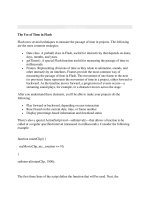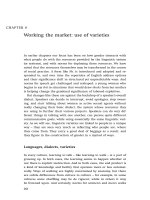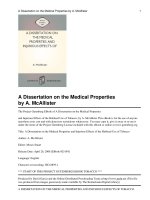Arthur james hale the synthetic use of metals in organic chemistry nabu press (2010)
Bạn đang xem bản rút gọn của tài liệu. Xem và tải ngay bản đầy đủ của tài liệu tại đây (1.87 MB, 179 trang )
THE
SYNTHETIC USE OF METALS
IN
OKGANIC CHEMISTEY
ARTHUR J. HALE, B.SC.(LOND.), A.I.O.
FELLOW OF THE OHKMIOAL SOOU'lTY; LHOTURKK, A.TST)
IN CHicariaTRy AT THK crrY AND aviu)H TKOiiwroA.L
COLLKGK, l^INHBUltY, LONDON
LONDON
J.
&
A.
C H U R C H I L L
7, aREA.T MARLBOKOUO-H STEEET
l-0 5V
/
*
"
"
•
LIBRARY
www.pdfgrip.com
PKEFACE
THE student of Organic Chemistry will probably
be impressed at an early stage with the importance
of metallic sodium and its compounds in synthetic
work, and will subsequently mark the value of such
substances as acetoacetic-, malonic-, and cyanaceticester and their sodium compounds.
He will notice the use of aluminium chloride in
the preparation of various aromatic compounds, will
hear the story of the discovery of the zinc alkyls,
and will possibly be attracted by those interesting
bodies, the organo-rnetals.
Various metals arid metallic, derivatives have been
utilised in the development of Organic Chemistry,
and during recent years, much attention has been
given to the use of magnesium in the Grrignard
reaction and to the value of the carbides in the
fixation of atmospheric nitrogen, while the reduction
and synthesis of organic compounds in tlio presence
of reduced nickel and other metals has, by development, led to the discovery of numerous catalytic
changes in thewww.pdfgrip.com
presence of certain metallic oxides.
VI
PREFACE
In this volume an attempt has been made to
present an account of the uses to which the metals
and certain of their compounds have Tbeen put, and
the work is based upon a course of lectures, on this
subject, recently given by the author to the advanced
students of Finsbury Technical College.
Each chapter is supplemented by an appendix of
practical work exemplifying the methods mentioned
in the text.
Most of the preparations have been carried out in
the College laboratories, and in connection with fthis
part of the work the author desires to acknowledge
the valuable assistance of two advanced students,
Messrs. T. McLachlan and E. Mendoza. He is also
indebted to Mr. F. W. Streatfeild, F.LC., Senior
Demonstrator, for help during the reading of the
proofs.
A. J. H.
LONDON;
February, 1914.
www.pdfgrip.com
CONTENT^
CHAPTER I.
SODIUM AND POTASSIUM.
Synthetic Use of t h e Metals—Sodium ethylate—Sodamide
—Sodium hydroxide—Potassium cyanide—Potassium
"bisulphate—Potassium hydroxide —Potassium nitrate
—Potassium and sodium disulphates
.
.
.
.
1
CHAPTER I I .
COPPER AND SILVHXt.
Use of the Metals—Copper acetylene derivatives—Silver
cyanide—Silver hydroxide
35
CHAPTER III.
MAG-NESIUM, CALCIUM AND BARIUM.
Applications of the Grignard reagent—Carbides of Calcium
and Barium—Nitrogen fixation—Calcium and Magnesium nitrides—Hydroxides of the metals .
42
CHAPTER IV.
ZINO AND MERCURY.
Metallic Zinc—Zinc chloride—Mercuric oxide—Metallic
mercury
www.pdfgrip.com
^
V1U
CONTENTS
CHAPTER V.
ALUMINIUM, TIN AND LEAD.
PAGE
Aluminium chloride—Aluminium-mercury couple—Tin and
lead organo-metallie compounds—Tin tetrachloride—
Lead oxide—Antimony and the chlorides of antimony—
Vanadium pentoxidc
11
CHAPTER VI.
IRON, NICKEL AND PLATINUM.
Ferrous sulphate—Ferrous potassium oxalate—Iron and
ferric chloride—Reduction by reduced iron, nickel or
cobalt
88
APPENDIX I.
PRACTICAL WORK: SODIUM—POTASSIUM.
Ethyl benzene—Anisole—Benzoic anhydride—Hexamethylene—Trimethylene dicarboxylic acid—Chlorof ormic
ester—Carbonyl chloride—• Ethyl benzoate—Toluic ethyl
ester—Aeetoacetic ester—Ethyl acetoacotic ethyl ester
—Aceto-succinic ester—Malonic ester—Ethyl malonic
ester—Diaceto-succinic ester—Ethane tetra-carboxylic
ester — Acetyl-acetoacetic ester—Antipy rine—Methyl
succinic ester—Succino-succinic ester—Tin tetraphenyl
—Lead tetraphenyl—Mercury diphenyl—Silicon tetraphenyl—Oxalyl-acetic ester—Hydroxy-methylene camphor—Acetyl-acetophenone—Ethyl acetophenone—Furfurol acrolein—Cinnamyl-vinyl-methyl ketone—Acetic
anhydride — Benzoin — Desyl-acetophenone — Phonanthroxylene-acetoacetic ester
104
APPENDIX II.
PRACTICAL WORK : COPP1R—SILVER.
Acrolein—Acrylic acid—/3-Iodopropionic a c i d — A d i p i c a c i d
—Carbazole—o-Nitrophenyl-propiolic acid—Di-o-nitrop h e n y l - d i a c e t y l e n e — o-Chlor - t o l u e n e — o-Chlor-benzoio
acid—jp-Chlor-toluene—Formaldehyde
.
.
.
.
www.pdfgrip.com
128
CONTENTS
IX
APPENDIX III.
PRACTICAL WORK: MAGNESIUM—CALCIUM.
PAGK
Benzoic acid—Phenyl-ethyl-carbinol—Trimethyl carbinol—
Triphenyl carbinol—Camphoric anhydride—Homo-camphoric acid—Camphor—Pentamethylene—Cyanamide . 137
APPENDIX IV.
PRACTICAL WORK : ZINC—MERCURY.
Citric acid—Use of Zinc alkyl iodide—Naphthalene—Isoquinoline—ITuorescein—Malachite green—Acridine—
a-Methyl-indole—Propyl chloride—a-Ethoxy-quinoline
—Phthalic acid
144
APPENDIX V.
PRACTICAL WORK: A L U M I N I U M — T I N — L E A D .
Dimethyl-aniline-phosphor-chloride — jp-Tolxiic-aldehyde —
Diphenyl-methane—a-Hydrindone—Triphenyl-methane
—Acetophenone—o-Benzoyl-benzoic acid—Anthraquinone — Hydrolysis of anisole—Toluene—Diphenyl—
Oxalic acid
153
APPENDIX VI.
PRACTICAL WORK: IRON—NICKEL.
o-Amino-benzaldehyde—o-Amino-cinnamic acid—Mannose
—Hexahydrobenzene—Hexahydrophenol
.
.
.162
INDEX
www.pdfgrip.com
167
www.pdfgrip.com
ABBREVIATIONS USED IN THE
BIBLIOGRAPHY.
= Liebig*s Annalen der Chemie.
« Annales de Chimie et de Physique.
= Berichte der deutsohen chemischen
G-esellschaft.
Bull. Soc. chim.
= Bulletin de la Soci6t6 chimique de Paris.
Chein. Centr.
= Chemisches Centralblatt.
Chem. Zeit.
= Chemiker-Zeitung.
Compt. rend.
~ Comptes rendus de TAcad&nie des
Sciences.
D.R.P.
German Patent.
J. Am. Chem. Soc ~ Journal of the American Chemical
Society.
J. Soc. Chem. Ind. = Journal of the Society of Chemical
Industry.
J. prakt. Chem.
= Journal fur praktische Chemie.
Monats.
— Monatshefte fur Chemie.
Phil. Trans.
= Philosophical Transactions.
Proc.
= Proceedings of the Chemical Sooiety.
Rec. Trav. Chim.
« Recueil des travaux chimiques des PaywBas.
Trans.
= Transactions of the Chemical Society.
Zeit. ang-ew. Chem. = Zeitschrift fur angewandte Chemie.
Zeit. phys. Chem. www.pdfgrip.com
» Zeitschrift fur physikalische Cheniie.
Ann.
Ann. Ch. Phys.
Ber.
www.pdfgrip.com
THE SYNTHETIC USE OF METALS
IN ORGANIC CHEMISTRY
CHAPTER* I
SODIUM AND POTASSIUM
ALMOST the first metal to Tbe used for organic
synthesis, sodium continues to hold a foremost position among all the metals utilised as synthetic agents
in organic chemistry.
Although potassium was the
first used, being applied by Frankland and Kolbe
in 1848 to the preparation of hydrocarbons by heating the metal with alkyl nitriles^ yet sodium has
always received a far wider application. Twentythree parts by weight of sodium suffice to bring
about a chemical change which would require tho
use of thirty-nine parts of potassium^ and thin fact,
together with the lower price of sodium, gives tho
metal an economic advantage.
Another reason for the priority of tins metal is that
in many cases the more electro-positive and moro
chemically active potassium
proves to be too violent
www.pdfgrip.com
2
SYNTHETIC USE OF METALS
in its action, and renders the control of the reaction
difficult.
After the investigation of Frankland and Kolbe
mentioned above, Frankland in the following year
heated metallic zinc with alkyl iodides, and besides
preparing paraffin hydrocarbons in this way, he
also discovered the zinc alkyl s, the first of the
organo-metallic compounds.1
In 1850, Williamson prepared certain ethers by
the interaction of alkyl iodides and sodium ethoxide,
a method of preparation which rendered evident the
constitution of these bodies :
C 2 H 5 I + C2H6O]Sra = ]STaI + C 2 H 5 .O.C 2 H 5 .
In 1855, Wurtz emphasised the importance of
sodium for preparing the paraffin hydrocarbons, and
prepared di-isobutyl, by the action of the metal
upon isobutyl iodide3:
2(CH a ) 2 CH.CH 2 I + 2Na - (CH 3 ) 2 CH.CHo.CH 2 .CH(CH 3 ) 3 + 2NaI.
A few years later, Fittig applied this reaction to
the synthesis of aromatic hydrocarbons by condensing
aryl and alkyl radicles. The following reactions
will indicate the usefulness of this method8 :
C6H6Br + CH 3 Br + 2Na = C6HB*CH3 + 2NaBr.
Brombenzene. Methyl
Methyl benzene
bromide.
(toluene).
CBH4Br2 + 2C2HfiI + 4Na C 6 H 4 (C a H 6 ) a + 2NaI + 2NaBr
Dibrom-benzene. Ethyl iodide.
Diethyl-benssene.
In these changes the alkyl groups take up the
positions occupied by the halogens in the benzene
nucleus.
After 1850, various compounds
were prepared by
www.pdfgrip.com
SODIUM AND POTARBIUM
3
the agency of sodium and potassium, and tin* following are examples of some of the bent known reactioiiH
of this class:
Phenol and other formation :
CflHftONn + Oir,I
Sodium phonate,
«
(yr fi .O.0H 3 + Nal
AtitHolo
(methyl phonyl othor).
The samo exchango is offoctod by lining an alkyl
sulphate or an alkyl liydrogon nulphato :
CaH4OK + O a ir B nS0 4 Ethyl hydrogon
sulphate.
2C 2 II 5 OK
+ (Cir8),so4
«
CaUft.O.O.jlT, + KHHO,
2cyr&.o.air3 + Kaso4
Methyl Htilphato. Ethyl mothyl othor.
The following aro chai*actoriHtic roacjtionn of
alkyl potassium sulphates:
When hoatod alone tht^y yield OI
Cari6KSO4 « iUU
When boiled with water tjuvy yit^ld alcohols:
O a II ft KS() 4 •»• II a O
'
cyiftOH -i- KUBO 4 .
When treated with KI, KCJN, K2H, KHH, thisy
yield alkyl iodidos, nitriloH, thio-others and morcaptans respectively:
RKSO4 + icr ^ m + Kaso4
RKHO4 + KXIN *. IU1N i K..S()4
2KKS<)4 + IC,8 ™. K.H.R + ak 3 HO 4
KKBO 4 + KSII « K.H.II. + K9H()4.
When heated with the alkali salfcH of organic ncidH,
esters are obtained ;
RKSO4 + OH8OO()K
s CirsCOOR + K.HO,
KKSO4 + OflllflCOO^a - €flir
*
Sodium
bonzoato.
www.pdfgrip.com
4
SYNTHETIC USB OF METALS
Acid anhydrides are produced by distilling a
mixture of the acid chloride with an alkali salt of
the acid :
CH3COC1 + CH3COONa = (CH3CO)X> + NaCl
Acetyl chloride.
Acetic anhydride.
C6H5COC1 + C6H5COOK (CCH5CO)2O + KC1
Benzoyl chloride.
Benzoic anhydride.
Numerous hydrocarbons can be prepared by the
action of sodium upon halogen substitution products.
In addition to those already mentioned, unsaturated hydrocarbons can.be synthesised in this
way:
2CH 2 : CH.CH 2 I + 2Na « CH 2 : CH.CH 2 .CH 2 .CH: CH 2 + 2NaI
Allyl iodide.
Diallyl.
2CH 2 : CHBr + 2Na = CH-: CH.CH: OIL + 2NaBr
Vinyl bromide.
Divinyl.
Sodium has played an important role in the preparation of many polymethylene hydrocarbons and
their derivatives.
The first member of this series of hydrocarbons
was prepared by Freund (1882), by allowing sodium
to act upon trimethylene bromide4 :
yCH2Br
y CIL
CH/
+ 2Na == Oil/ I " + 2NaBr.
\CH2Br
"\CH 3
The same method was used in 1888, for preparing
methyl tetra-methylene from 1 : 4-dibrompentane5 :
CH3.CHBr.CHo.CHfl.CH2Br + 2Na
»
CH3.CH.. CH
C2
|
I + 2NaBr,
CH 2.CH 2
and again in 1894 for preparing hexamethylene from
the corresponding dibromide
:
www.pdfgrip.com
SODIUM AND POTASSIUM
CH3.CH2.CH2Br
|
+ 2Na
OH2.CH2.CH2Br
-
0
CH2.CH2.CHS
|
|
+ 2NaBr.
OH2.CH2.OH2
Cyclohexane.
Many polymethylene carboxylic acids can bo propared by the aid of di-sodium malonato :
CIl.Br
/COOC.JIs
OH2Br
\COOCaH6
CHa\
/COOOIIj + 2NaBr
0 H 2 / \CO0C a H s
Triinetliylene dicarboxylic oatoir.
The condensation product when hydrolysod givon
the corresponding acid and the latter on heating,
passes to a monocarboxyl compound :
CHo\N XyCOOH
| " C
C H 2 / \COOH
Heat
->
CPL>\N
| " CH.CO0H -i- COo.
CIL/
Similar compounds are formed by using triinothylene dibromide and pentamethyleiio dibromido.0
Numerous acids may bo prepared by tlio action of
carbon dioxido upon aromatic halogen compounds, in
the presence of sodium.
This method was first used by Kekule iu 186(3 for
preparing benzoic and toluic acids from brombonzouo
and bromtoluene:
CoHfiBr + CO3 + 2Na == C(5HftCOONa + NaBr
/OH 3
.CH,
C6H4<
+ COo + 2Na = C()II4<
+ NaBv.
x
Br
XiOONa
Magnesium is now used instead of aodium for this
type of reaction (see later).
Wurtz, by the aid of chloroformic oalor, prepared
the corresponding esters of these itcids:
C6H5Br + 2N"a + CICOOC-H5
« 0 ^ . 0 0 0 0 ^ -I- NaCl + Kalir.
www.pdfgrip.com
6
SYNTHETIC TTSJE OF METALS
USES
OF ACETO-ACETIC
ESTEB.
This useful r e a g e n t was discovered b y G-euther in
1863, who pi*epared it b y the action of sodium upon
ethyl acetate.
About t h e same time F r a n k l a n d a n d D u p p a , using
the same reaction, discovered t h a t t h e h y d r o g e n
atoms of t h e raethylene group a r e replaceable b y
sodium and various organic radicles.
G-euther r e p r e s e n t e d t h e substance as O H 3 . C ( O H )
: CH.COOC 2 H 6 , t h a t is /3-hydroxycrotonic ester, b u t
Frankland a n d D u p p a preferred t h e k e t o formula
OHg.CO.OHg.OOOOgHg, a n d r e p r e s e n t e d it as acetoacetic ester. 7
The formation of t h e substance m a y b e r e p r e s e n t e d
thus:
CH3.COOC2H5 + CH3.COOC2H5 = CH3.CO.CH2.COOC3H6 + OftOH.a
Wislicenus h a d b y 1877, i n v e s t i g a t e d t h e substance
and shown t h a t o t h e r substances contained m e t h y lene groups, t h e h y d r o g e n of which could b e replaced
by sodium. 9
A few years later, Conrad showed t h a t an alcoholic
solution of sodium ethoxide would suffice, in place of
metallic sodium or t h e d r y ethoxide, for this type of
reaction; he applied his method in p a r t i c u l a r to t h e
preparation of alkyl malonic esters. 1 0
Not only does condensation t a k e place between two
molecules of a n ester such as acetic ester, b u t also between an ester a n d a ketone. A c e t y l acetone can be
prepared, for e x a m p l e , from acetic ester a n d acetone :
OH3.COOC2H5 + CH3.CO.CH3 « CH3.CO.CH2.CO.CH3 + C2H5OH.
Propionic a n d b u t y r i c esters u n d e r g o t h e
type of c o n d e n s a www.pdfgrip.com
tion:
same
SODIUM AND POTASSIUM
7
2CH 3 .CH 2 .COOC 2 H 5 « CH3.CH2.CO.CH.COOC2H6 + C2H6OH
2C,H B .CH a .COOC 3 H s
CH 3
Propio-propionic ester.
== C,Hfi.CHa.CO.CH.CO0CaH5 + G f t O H
C2H5
Butyrobutyric ester.
Iii both cases the carboxyl group of one molecule
of the ester attaches itself to the a-carbon atom of
the other. The yields in both cases are lower than
that obtained with acetic ester, which is about 25
per cent, of that calculated.
Isobutyric and isovaleric esters were found by
Hantzsch11 to follow a different course.
The compound which might be expected when
using isobutyric ester could not be isolated, and was
apparently reduced by the sodium present to ethoxycaprylic ester, while simultaneously some of it
becamo hydroiysed to hydroxycaprylic acid thus :
(CH a ) 2 CH.C(OH)(OC 2 H 6 ).C(CH 3 ) 2 .COOC 2 H s
Not isolated.
P a r t l y reduced to (CH 3 ) 2 CH.CH.(OC 2 H 6 ).C(CH 3 ) l ,COOC 2 H 6
Etlioxycaprylic ester.
P a r t l y hydroiysed to (CH 3 ) 2 CH.CH(OH).C(CH 8 ) 2 .COOH
. .
Hydroxycaprylic acid.
Similar changes occurred when using isovaleric
ester and are represented by the following equations :
2(CH3)2CH.CH2.COOC2H5 - •
(CH3)2CH.CH.vC(OH) (OC2H6).CH.C3H7.COOR
Not isolated.
(CXr3)2CH.CHo.CH(OC2H6).CH.C3H7.COOCoH5 Ethoxycapvic ester.
(CH 8 ) 2 CH.CH 2 .CH(OH).CH.C 3 H 7 .COOH
Hydroxycapric acid.
Acetoacetic ester was the first of those compounds
to be studied, which
contain the grouping—00 —
www.pdfgrip.com
8
SYNTHETIC USE OF METALS
CH2—CO— , the hydrogen of the methylene group
(CH2) being replaceable, entirely or in part, by
sodium. Around its constitution and principal reactions much controversy was destined to take place,
and even now the last word has not been heard concerning this important and interesting substance.
Geuther, endeavouring to show that a second
hydrogen atom of acetic acid could be replaced by
sodium, caused the metal to act upon acetic ester.
Hydrogen was evolved, sodium ethoxide was formed,
and a solid sodium compound was isolated, having the
composition C0H9O3Na, which on acidifying yielded
an oil capable of forming salts with bases. Geuther
also proved that by the action of alkyl iodides the
sodium was replaced by alky], and this fact was confirmed shortly after by Frankland and Duppa.
Wislicenus next showed that the product under
discussion was acetoacetic ester and that two hydrogen
atoms were replaceable by sodium in two stages.
He represented the reactions in the following manner,
adopting the formula of Frankland:
(i) CH a .CO.CHNa.COOC a H 8 + C 3 H 6 I CHs.CO.CH(C 2 H 6 ).COOC 2 H 6 + N a l
(ii) CH 8 .CO.CNa(C 2 H 6 ).COOC 2 H 5 + C 2 H 5 I =
CH 8 .CO.C(C 2 H 5 ) 2 .COOC 2 H 5 + N a l
Geuther ascribed the enolic or hydroxylic formula
CH3.C(OH):OH.COOC2H6 to the substance, maintaining that it explained better its chemical nature.12
Claisen was the first to propose an important explanation of its mode of formation, and offered a view
which is still regarded with favour.13 This view is,
that the condensation
of acetic ester, and other conwww.pdfgrip.com
SODIUM AND POTASSIUM
9
densations of this type, take place through the
formation and subsequent decomposition of an intermediate addition compound, in the formation of which
sodium ethylato plays an important role. The stages
of the reaction may therefore be represented thus:
.ONa
CH3.COOCJSfi + CaH6ONa = CU3.C-OCaHfi (Intoraodiato com-
CH3.COOCaHB »
CH3.C(ONa): CH.C0O0.2H6 + 2CaH5OH.
Sodium derivative.
The sodium derivative is decomposed by weak acids
yielding acetoacetic ester, for which reason tho
derivative is frequently represented with sodium
linked to carbon directly and the liberation of tho
ester is then represented thus :
CH3.CO.CHNa.COOC2H6 + HC1 - CH:i.CO.CUa.0OOC3Hb 4- NaCl
The above intermediate compound has not boon
isolated; but by tho interaction of bouzoic molhylester and sodium benzylate an analogous compound
has been produced and separated.
/
C6H5.COOCH3 + C0H6.CILONa - CUHB.C -
Other compounds containing a metliyleno group ;
the hydrogen of which is replaceable by sodium aud
by alkyl groups, are :
Acetyl acetone
CHBCO.Cir3.OO01Ia
Malonic osier
0^000.0JJ 3 .COOU s ll fi
Acetone clicarboxylio estor
CoH^OOC.CHa.CO.CH
Cyanacotio oster
NC.CIt..COOCaUi
Benzyl cyaixido
^;
Deoxybenzoin
www.pdfgrip.com
10
SYNTHETIC USE OF METALS
A few applications illustrating the value of these
sodium derivatives may now be outlined.
The sodium derivative of acetoacetic ester, prepared by treating the ester with an alcoholic solution
of sodium ethylate, is converted into an alkyl substituted ester by boiling with any alkyl iodide:
CH 3 .CO.CH 2 .COOaH 5 -> CH3.CO.CH]Sra.COOC2H5 -*
CH3.CO.CHR.COOC2H6
A second radicle II1 may be caused to replace the
second hydrogen of the methylene group, by repeating the treatment with sodium ethylate and an alkyl
iodide E a I.
CH3.CO.CHRCOOC0H5 -» CH3.CO.CNaR.COOC2H5 -»
These substituted esters, like aceto-acetic ester
itself, can be hydrolysed in two different ways and
thus yield a variety of ketones and acids of the
acetic series.14
Boiling with dilute acid or dilute alkali brings
about ketonic hydrolysis chiefly :
R
CH3.CO.C.COOCaH6 + Sift = CH3.CO.CHRR1 + CO2 + C 2 H 6 OH,
I
Kotone
while boiling with strong alkali favours acid hydrolysis :
R
CH3.CO.C.COOCoH5 + 2 H 2 O - CH 3 COOH + CHRR^COOII + C 2 H 3 OH.
I
Acid
R1
Malonic ester in particular can be used for preparing higher acids of the acetic series by first
www.pdfgrip.com
SODIUM AND POTASSIUM
11
replacing one or both of the methylene hydrogens
by an alkyl group :
yCOOC2H5
/COOC2H5
yCOOC3H6
CH2;
- * CHRX
or C&R1 (
\COOC 2 H 5
\COOC2H5
\COOC 2 H 5
On hydrolysis these substituted malonic esters
give the corresponding acids and the latter on being
heated to 200° lose carbon dioxide :
yCOOH
/COOH
CHEf
-»B.CH,.CO0H; CKBF
-» ERlCH.COOH
\COOH
"
\COOH
The monosodium derivative of aceto-acetic ester
on treatment with iodine undergoes condensation to
a dibasic ester (diaceto-succinic ester).
CH 3 .CO.CHNa.COOC,H 5
+ I2 »
CH.,.CO.CHN*a.COOC2H5
CH3.CO.CH.COOC2H5
|
+ 2NaI
CH3.CO.CH.COOC2H6
The mono-sodium compound of malonic ester
gives a tetra-carboxylic ester when similarly treated
(ethane tetra-carboxylic ester):
C
OC2H5
CH(COOC 2 H 6 ) 2
OC3H6
+ Io == • |
+ 2NaI
" OH(COOC2H6)2
Acetyl aceto-acetic ester is prepared by the action
of acetyl chloride upon the compound 0H s .0O.0H
Na.COO03H5, and on hydrolysis gives acetic and
aceto-acetic acids :
CH3.CO.OH.COOC3HB
I
+ 2H2O =
COCH,
CH3.COOH + CH3.C6.CH3.COOH + O2HCOH
In a similar manner, by using a-monochloracetone,
the y-diketone, acetonyl acetone, is obtained after
www.pdfgrip.com
hydrolysis15:
12
SYNTHETIC USE OF METALS
CH3.CO.CHNa.COOCoH(5 + CICH3.CO.CH3 =
CH3.CO.CH.COOC3H5 + NaCl
CHa-COCHa
Heating with water at 160° is sufficient to hydrolyso the substitution compound and eliminate carbon
dioxide :
CH3.CO.CH.COOC3II5
CH3.CO.CH.COOH
cH3.co.CH3
CH S .CO.CH 3 "*
CH3.CO.CH3.CH2.CO.CH3 + CO3
Acetonyl acetone affords a means of passing tu
furf urane, thiophbne, and pyrrol derivatives. Heated
with dehydrating agents such as zinc chloride or
phosphorus pent oxide, it yields dimethyl furfurane,
a change which is sometimes explained by the
following steps:
CII:
1
6H3.CO.CH3
CH3COCH3
->
0H
OH
O
C
/
~" > y °
OH : V .CHa
Heated with phosphorus pentasulphide it yields
the corresponding thiophene compound, while the
action of alcoholic ammonia solution forms a pyrrol
compound:
SB*
-^xh
CH • C<
' \QT-J
diniothyl-tliiophene
CH : CV.CHJI
C H * c^
'
^ * -Cri^
dimothyl-pyrrol
www.pdfgrip.com
SODIUM AND POTASSIUM
13
The behaviour of sodium ethyl aceto-acetate towards chloracetic ester and chloroformic ester respective! jy indicates that the compound exhibits dynamic
isomerism because in the first reaction it behaves
as though sodium were directly united to carbon, and
in the second reaction as though the sodium were
united to oxygen :
CH3.CO.CHNa.COOG>H5 + C1CH2.COOC2H5 =rCH:}.CO.CH.COOC2H6
CH?.COOC2H5
Aceto-succinic ester
, OCOOGft
CH3.CONa : CH.COOC,H5 + C1COOC2HS = CH3.C £
^CH.COOC 2 H fi
/3-carbethoxy-crotonic ester
From acetyl-acetone a series of j3- or 1: 3-diketones can be obtained by treating the mono-sodium
compound with alkvl iodides :
I 3 + CHJE =
CH3.CO.CH(C2HB).CO.CH3 + Nal
Treatment of the sodium derivative with iodine
gives tetra-acetyl ethane :
CH3.CO.CHNa.CO.CH3
CHa.CO.CHNa.CO.CH3
CH3.CO.CH.CO.CH3
+
* " CH3.CO.CH.CO.CHf
Aceto-acetic ester is technically valuable in the
preparation of antipyrine. The ester is first allowed
to react with phenyl-hydrazine, and the ring compound formed is then convex'ted into antipyrin by
inethyl iodide and sodium :
CH3.CO.CH3.COOCSH5 + CflHfi.NH.NH2
"CH f.- 2 ' CO -° CiI15 +
www.pdfgrip.com
14
SYNTHETIC USE OF METALS
The hydrazone then loses C2H5OH and forms
l-phenyl-3-rnethyl pyrazolon :
CH3.C : CH.CO
"L-J.Q.B.
which then passes to 1 : 2 : 3-phenyl dimethyl-pyrazolon.
From benzyl cyanide and deoxy benzoin alkyl
derivatives can be formed by the action of sodium
and alkyl halides:
C6H5.CH3.COCflH5 -> CCH5.CHR.COCGH6
The preparation of dimethyl succinic ester will
illustrate the use of cyanacetic ester.16
The sodium compound is condensed with a-brompropionic ester to form cyano-methyl succinic ester :
CN
CH a
CHNa + Br.CH
COOC2H5
-
COOC2H5
CN
CH 3
CH
CH
+ NaBr
COO2IIfi COOC2H5
This substance is then treated with ISTaOEt and
OH3I and the product hydrolysed with loss of carbon
dioxide:
CN
CH,
+ CH 8 I «
- /innp TT
COOC
COOCjHg
2H5
Hydrolysis
COOH
CH 3
"*
6.CH 3
CH
CN
CH.,
I
I
C.CH8
CH
+ Nal
nC\(
—
COOCaHa
COOC2H5
-CO2
CH 3
CH 3
~>
CH
CH
COOC2H5 COOC2H6
COOC2H5 COOCjHs
The synthesis of S-keto-hexahydrobenzoic acid
further illustrates the use of cyanacetic ester.17
www.pdfgrip.com
SODIUM AND POTASSIUM
15
The di-sodium derivative is condensed with /3-iodopropionic ester to form y-cyanopentane-a-ye-tricarboxylic ester :
C2H5OOC.C(CN)NA2 + 2CH2I.CH2.COOC2H5
/CI12.CH2.COOC2II,
= C2H5OOC.C(CN)
+ 2TSM
\CH2.CH2.COOC2H5
Hydrolysis of this cyano-ester gives pentane-ayctricarboxylic acid, which on digestion with acetic
anhydride and subsequent distillation yields S-ketohexahydro-benzoic acid:
,CH2.CH2.COOH
,CH2.CH2
HOOC.CH
= HOOC.CH
N c O + CO2 + H 2 O.
\CH 2 .CH 2 .COOII
\C
Further examples of the synthesis of cyclic compounds are :
The formation of butane tetra-carboxylic ester
from ethylene dibromide and mono-sodium-malonic
ester:
OHjBr
CH(Na) (COOC2H6)2
CH2.CH(COOC2H6)2
I
+ I
= |
+ 2NaBr
CI!H2Br
CH(lSra) (COOC2H5)2
CH2.CH(COOC2H5)2
When the sodium derivative of butane tetracarboxylic ester is acted upon by bromine, the resulting product is tetramethylene-1 : 2-tetracarboxylic
ester:
CH 2 .CNa(COOC 2 H 6 ) 2
CH 2 .CNa(COOC 2 H 5 ) 2
CH2.C(COOC2H5)2
+
^ " CH2.C(COOC2H5)2
The use of trimethylene
bromide with sodium
www.pdfgrip.com









